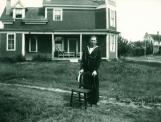1
Wilf as a babycirca 1890
Lobo Township, Middlesex County, Ontario, Canada
 Credits:
Credits:Museum of Ontario Archaeology
2
William Wilfrid Jury (1890-1981) was born at home on July 1, 1890. He was named William after his grandfather and great grandfather, but his family and he adopted the habit of going by his second name Wilfrid. Wilf attended Lobo S.S. #9, a one-room rural school later known as the "Jury School" since it had been built on the corner of the Jury farm.3
Wilf with mother Juliacirca 1895
Lobo Township, Middlesex County, Ontario, Canada
 Credits:
Credits:Museum of Ontario Archaeology
4
As a young boy Wilf develped the attitude that more could be learnt from experiencing life rather than from studying text books, so he quit school after having completed only Grade 6 or 7. He spent the next few years helping out around the farm, going on extended hunting and fishing expeditions to the Port Franks area with Amos and building up his collection of artifacts. It was during this period that he learnt about the traditional Native way of life from Chief Alex Elijah. As time passed Wilf came to be known for his artifact collection and he was given the name "Heap of Stones" by the Little Bear Clan: this honour allowed him to participate in certain ceremonies on the Oneida Reserve. The athletic Wilf played baseball and hockey for Lobo Township teams and he was invited to join the Oneida lacross team.5
Wilf and sister Irenecirca 1901
Lobo Township, Middlesex County, Ontario, Canada
 Credits:
Credits:Museum of Ontario Archaeology
6
Wilf was truly a patriotic man. He became one of the first Lobo Township residents to enlist for the First World War, joining the Navy in 1914. He first served as a recruiting officer based in London, then spent some time as a billeting officer stationed in Montreal and Quebec City. He then became Special Messenger to Commander Wyatt at Admiralty House in Halifax.7
Wilf in his naval uniformcirca 1917
Lobo Township, Middlesex County, Ontario, Canada
 Credits:
Credits:Museum of Ontario Archaeology
8
In February 1917 Wilf was serving for the Naval Volunteer Reserve in Halifax on the Royal Canadian Navy training ship H.M.C.S. NIOBE. He had the great misfortune of being in Halifax Harbour on December 6, 1917 when the Belgian steamer IMO collided with the French steamship MONT BLANC, loaded with nitroglycerine and trinitrotoluol. The resulting explosion and tidal wave resulted in over 1000 deaths and 5000 injuries while one-fifth of Halifax lay in ruins. Wilf was washed ashore, severely injured. In the mass confusion of the next few days the NAvy sent word home to Amos and Julia that Wilf was missing and presumed dead, but in fact he had been taken in by a kind Dartmouth family who nursed him back to health. He spent some time in the hospital before returning to limited duties in the Navy in January 1918, serving once again as Able Seaman on the NIOBE. However, Wilf contracted tuberculosis and was discharged for medical reasons in July 1918. He was awarded a War Service Medal and a British War Medal.9
Wilf in uniform1917
Lobo Township, Middlesex County, Ontario, Canada
 Credits:
Credits:Museum of Ontario Archaeology
10
Wilf after WWIcirca 1920
Lobo Township, Middlesex County, Ontario, Canada
 Credits:
Credits:Museum of Ontario Archaeology
11
Wilf returned home but immediately entered Queen Alexandra Sanatorium in Byron (now London, Ontario) to undergo treatment. He spent the next seven years in and out of "the San", not only receiving TB treatments but also being tutored by Dr. Andrus who shared a similar interest in Canadian history. The doctors advised Wilf to get as much fresh air as possible into his damaged lungs, and he took their advice - literally - by moving to Oregon to "live like a Native":12
Wilf as a young mancirca 1920
Lobo Township, Middlesex County, Ontario, Canada
 Credits:
Credits:Museum of Ontario Archaeology
13
"I was fully aware that in order to make a complete study of the Indian, his habits and customs, one would have to live for a time as the Indian under similar conditions. Leaving the San with a full pension, my money problem was solved, I had an uncle living in Cottage Grove, Oregon, who had kindly asked me to come out and visit them. Accepting this invitation I soon found myself in the little town of Cottage Grove in the heart of Willamott Valley. I was not interested in Indian artifacts in that district, but was interesting in erecting an Indian type house, making Indian artifacts under the same conditions they had accomplished the feat, making and baking my own cooking utensils from clay, growing and smoking in clay-made pipes tobacco mixed with willow bark" (Wilfrid Jury, 1972 autobiography).14
Wilf as a young mancirca 1920
Lobo Township, Middlesex County, Ontario, Canada
 Credits:
Credits:Museum of Ontario Archaeology